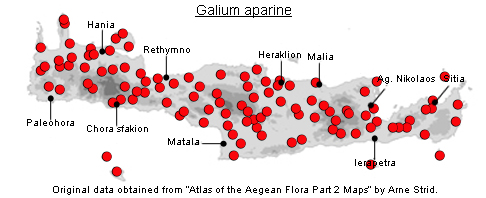
GALIUM APARINE
Family and Genus:- See- RUBIACEAE/Sect. KOLGYDA
Common Names:- Common cleavers, Goose grass.
Homotypic Synonyms:- Rubia aparine, Valantia aparine.
Meaning:- Galium (Gr) Milk.
Aparine (Gr) A name used by the Greek philosopher Theophrastus for
goosegrass.
General description:- Moderately branched, scrambling, herbaceous annual.
Stems:-
1) 20-80 cm long and 2-4 mm wide, retrorsely aculeolate on the angles, often stout
and hairy at the nodes.
Leaves:-
1) In whorls of 6-8, usually 20-30 x 2-6 mm, narrowly oblanceolate, retrorsely
aculeolate on the margins, tapering to a hyaline arista. upper surface glabrous
but provided with hooked prickles.
2) Stipules, similar to the leaves.
Flowers:-
1) Inflorescence, diffuse, consisting of 2-7-flowered axillary cymes, usually
exceeding the subtending leaves.
2) Peduncles, long, straight, occurring at the axil of the leaves, with 4 partly fused
petals.
3) Corolla, 1.5-2 mm in diam., whitish.
4) Stamens, 4.
a) styles, 2.
Fruit:-
1) Mericarps, 3-5 mm, densely hispid with hooked setae arising from a tubercle-
like base.
Key features:-
1) Corolla, 1.5-2 mm in diam., whitish.
2) Mericarps, (excl. setae) 3-5 mm, always with hooked setae
Habitat:- Coastal habitats, gorges, olive groves, roadsides, wasteground. 0-1100 m.
occasionally to 1600 m.
Distribution:- Widespread and common throughout the Mediterranean. Widespread
and common on Crete.
Flowering time:- Apr-June, and sporadically at other times.
Photos by:- Steve Lenton
SPECIES DESCRIPTION
